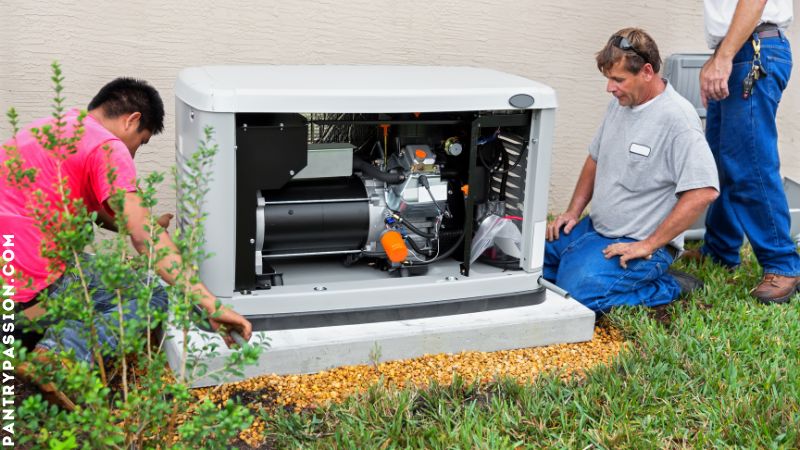The Best Fluffy Pancakes recipe you will fall in love with. Full of tips and tricks to help you make the best pancakes.

Keeping frozen breast milk cold during a power outage can feel stressful, but with a few smart moves, you can protect that liquid gold.
Check out How to Keep Food Cold During a Power Outage: Smart Tips for Fridge & Freezer Safety and Using a Generator to Keep Food Safe During a Power Outage.
Table of Contents
- Frozen Breast Milk: Before the Power Goes Out
- Frozen Breast Milk During Power Outage
- 🚗 Bonus Tips
- What to Include in a Breast Milk Emergency Kit
- 🚨 Pro Tips
- FAQs
Frozen Breast Milk: Before the Power Goes Out
- Pack the freezer tightly: Fill empty spaces with frozen food, ice packs, or even frozen water bottles. A full freezer stays cold longer—up to 48 hours if unopened.
- Center the stash: Place frozen breast milk in the middle of the freezer, surrounded by other frozen items for insulation.
- Use freezer bags with minimal air: Less air means better insulation and slower thawing.

Frozen Breast Milk During Power Outage
- Keep the freezer closed: Every time you open it, you lose precious cold air. Resist the urge to check!
- Look for backup storage: Ask neighbors, friends, or even local restaurants or hospitals if they can store your frozen breast milk temporarily.
- Use coolers with dry ice or frozen goods: If you have dry ice, layer it in a cooler (never touching the frozen breast milk directly) and insulate with towels.
If Frozen Breast Milk Starts to Thaw
- Check for ice crystals: If there are still crystals, it’s considered frozen and safe to refreeze.
- Fully thawed breast milk: Must be used within 24 hours. Once it reaches room temperature, use it within 1–2 hours.
- Don’t refreeze thawed breast milk: It can degrade nutrients and increase bacterial risk.
🚗 Bonus Tips
- Manual or battery-powered pump: Keep one handy in case you need to express breast milk without electricity.
- Car adapter: Many breast pumps can run off your vehicle’s power if needed.
- Refer to the CDC for more information on storage of breast milk
What to Include in a Breast Milk Emergency Kit
❄️ Cooling and Storage
- Insulated Cooler or Thermal Bag: Choose one with thick insulation and a waterproof liner.
- Reusable Ice Packs or Gel Packs: Pre-freeze several, and rotate them if possible.
- Dry Ice (optional): Store in a well-ventilated cooler when long-term refrigeration is needed.
- FRIO Cooling Wallets: Great for short-term use without electricity—activated with water.
🧼 Cleanliness and Sanitation
- Breast Milk Storage Bags: Leakproof and easy to label.
- Sanitizing Wipes: For cleaning hands, pump parts, or bottle nipples.
- Hand Sanitizer: Alcohol-based, travel size.
- Ziplock Bags: For organizing clean vs. used pump parts or liners.
🧃 Feeding and Pumping Supplies
- Manual Breast Pump: No electricity required and easy to clean.
- Battery-Operated Pump: Keep extra batteries or a portable charger.
- Car Adapter or Portable Power Bank: For pumping while on the go.
- Bottles with Nipples: Include a few pre-sanitized bottles.
📋 Other Essentials
- Sharpie or Pen: Label breast milk with date/time and any notes.
- Thermometer Strip: To monitor cooler temperature inside the bag.
- Emergency Contact List: Pediatrician, lactation consultant, local hospital.
- Instructions Sheet: Include guidelines for breast milk storage, thawing, and feeding if someone else may help.
🚨 Pro Tips
- Rotate stock: Swap ice packs and check expiration dates monthly.
- Create two kits: One for home, one for your car or travel bag.
- Practice once: Try packing and using your breast milk emergency kit before an actual emergency so you know it works.
This kind of kit brings peace of mind knowing your baby’s nutrition is protected.
FAQs
How long can breast milk stay cold in a cooler?
Breast milk can safely stay cold in an insulated cooler with ice packs for up to 24 hour. To maintain its quality and safety:
Use frozen ice packs and pack them tightly around the milk containers.
Keep the cooler closed as much as possible to preserve the cold temperature.
Make sure the cooler stays below 39°F (4°C) to prevent bacterial growth.
After 24 hours, transfer the milk to a refrigerator or freezer if possible. If the milk has thawed completely or warmed up, it should be used within 2 hours or discarded.
Can I refreeze thawed breast milk?
Yes—but only if the milk is still partially frozen and contains visible ice crystals. In that case, it hasn’t fully thawed and can be safely refrozen. However, fully thawed breast milk should never be refrozen, as it may increase the risk of bacterial growth and reduce nutritional quality. Also, leftover milk from a feeding should not be refrozen, even if it still looks slushy.
For best safety:
Refreeze only milk with ice crystals.
Use clean containers and label with the original freeze date.
Avoid repeated freeze-thaw cycles to preserve nutrients.
How do I safely clean and sanitize breast milk storage containers during an outage?
When running water or electricity is unavailable, cleaning baby items can be tricky. You can:
Use boiled water (if you have a gas stove or camping burner) to sanitize bottles and pump parts.
Wipe down containers with alcohol-based sanitizing wipes (at least 60% alcohol) if boiling isn’t possible.
Store clean items in sealed bags or containers to prevent contamination.





